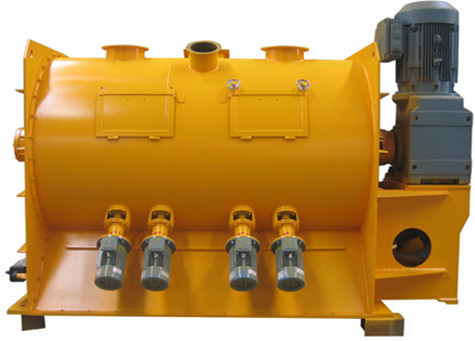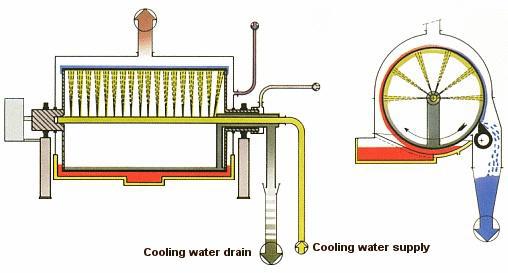Plough Share Mixer – With the development of stearic acid as agents for food and chemical industry, more and more complicated process mixing machine is needed in order to meet customer’s product requirement. We would like to share the process of stearic acid mixing as following: after filling raw material into mixer, the vessel will be heated by heating jacket up to 110 degree temperature. Then, there will be reaction inside mixer body and pressure will be happen in it. The pressure inside body will be around 2-3 barg. Steam and other chemical reaction result this pressure and we need vacuum pump to extract steam out from mixer body through vacuum drum. After reaction, the product inside mixer need to be cooled by cooling jacket and then discharge final product through valve. So, which type mixer is suitable for above application? How to design the mixer to meet above process? Vortex has know-how to share our experience:
A. Which type mixer is suitable for above application?
According to our experience, plowshare mixer is the best choice for stearic acid application because of following features:
- High speed mixing of reactants
- Prevention of over concentration
- No temperature gradients in the reaction field
- Multi phase process (reaction, heating, drying, granulation, cooling)
Plough Share mixer Description:
It has a cylindrical shell with plough shovel welded or bolted on arms and the shaft runs at high speed to effect a fluidizing action. The plough shovel lifts the material upward, and the material settles in a pattern. Whirling, three-dimensional product movement makes output material with very high homogeneity within short mixing time.
B. How to design the mixer to meet above process?
1. Seal Part: Considering pressure inside mixer body, the seal part of main shaft and chopper is very important. As for chopper, double action mechanical seal is necessary to avoid leakage. As for main shaft seal, if pressure below 1 barg, packing seal can be used but if pressure is big, we must use double action mechanical seal.
2. Discharge: Due to the process material will become from liquid paste to powder, ordinary discharge valve is not good. So, we design segment ball valve for discharge in order to avoid liquid leakage and easy discharge.
3. Drive Power: According to process, it is low speed at first during reaction and fast speed at last when material becomes powder. So, the drive unit must be strong enough and safety factor should be beyond 1.3. Due to hydraulic motor is complicated, we think about to use another way to instead it. Firstly, we design fluid coupling between drive unit in order to keep stable torque when slow speed start. Furthermore, we use double speed motor to have strong power when slow start.
4. Plough Shovel: Considering full and complete reaction inside mixer and material feature, we design asymmetric plough shovel in order to make material easy flow.
Anyway, different application has different design feature. So, if you have any inquiry about this kind of mixer, please feel free to contact us.
Sample Applications of Plow Mixers & Blenders:
IndustryProductChemicalCellulose, Powdered Metals, Glass Bubbles, Glass Beads, Ceramic, Abrasives, Wood Flour, Aluminum Powder, Vermiculite, Lime, Carbon Compounds, Graphite, Ash, Silica, Lithium Ore, Friction Material, Paint Waste, Welding Rod Flux, Brake Pad Material, Coal Fines, Molybdenum Trioxide, Nitrocellulose, Titanium Dioxide, Agricultural Chemicals, Herbicides, Biomass, Cerium Stearate, Tungsten Carbide Powder, Calcium Oxide, Pesticides, Fire Extinguisher Powder, Potassium Phosphate, Fly Ash, Zinc Oxide, Tungsten Oxide, Activated Charcoal, Cerium Oxide, Nano ParticlesFoodProteins, Grated Cheese, Cocoa, Starch Reaction, Bread Mix, Cake Mix, Spices, Drink Mix, Soft Drink Powder, Gelatin Dessert, Grain, Wheat, Soybean Meal, Animal Feed, Tea Powders, Sugar, Frosting, Coffee Beans, Oats, Dextrin, Candy, Confection, Citric Acid, Soup Mix, Whey, Fruit, Icing, Glazes, Cereal, Flax Seed, Pectin, Vanilla Bean, Okara, Bouillon, Stevia, TanninConsumer ProductsSoaps, Detergents, Dental Adhesive, Tobacco, Tooth Paste, Cosmetic Powders, Grouting Materials, Lipstick, Powdered ChalkMineralsMinerals, Iron Ore, Bentonite, Gypsum, Cement, Clay, Ferric Oxide, Calcium Carbonate, Talc, Limestone, Pollucite, SlagPharamaceuticalsDental Paste, API, Nutraceutical, Enzymes, Riboflavin, GinsengPlasticsPigments, Powder Coating, Gum Rubber, Wax, MelamineLet’s Connect!
Design, Construction, and Operation
The ploughshare mixer consists of a cylindrical drum containing plough shaped mixing elements that are mounted on a horizontal shaft. The agitator’s shaft is positioned in the centre of the drum and has welded / bolted arms on which the “Plough” shaped mixing elements are mounted. The ploughshare mixer gets is name because of these plough shaped mixing elements. Independently driven high-speed choppers may be installed to disperse agglomerations and control granulation during the mixing process.
The plough shaft is powered by a drive system comprising of a motor, gearbox, and couplings. The shaft exits the mixer drum at either end through the end plates bolted or welded to the cylindrical shell. The area where the shaft exits the container is provided with a sealing arrangement to ensure that material does not travel from the container to the outside and vice-versa. The mixer assembly along with the drive system components viz. motor, gearbox, couplings, and bearing supports is mounted on a supporting frame.
In operation, material is loaded through the top inlet. The working volume (volume up to which material should be loaded) of the ploughshare mixer ranges from 30% to 70% of the total drum volume. The shaft rotates at higher speed, producing a plough tip speed of more than 200 metres per minute to effect a fluidizing action. The ploughs throw the material upward, and the material settles in a random pattern. The size, shape, positioning, and peripheral speed of the ploughs are coordinated in such a way that they produce a whirling, three-dimensional product movement. The turbulence and material movement within the mixer container prevents formation of dead-spots or low-movement zones and ensures fast and homogenous mixing. The ploughs are designed to lift the material from the inside wall of the container without squashing the particles against the wall
The profile and arrangement of the ploughs ensure that after mixing, the material is directed towards the centrally located discharge valve. For larger mixers, more than one discharge valve can be provided depending on the requirement of the downstream process. Flush bottom discharge valves are preferred to avoid any dead pockets within the mixer. These valves may be manually, pneumatically of hydraulically operated. Large side doors may be provided for cleaning access.



